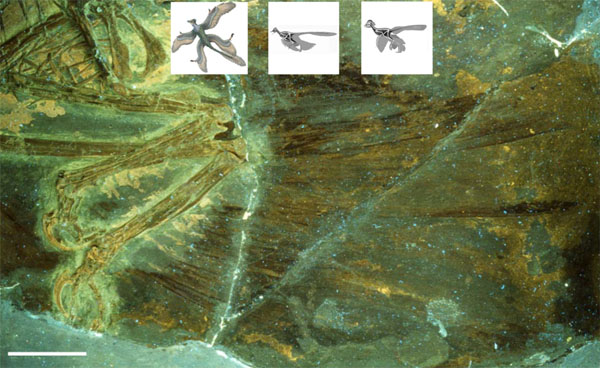Fig. (3) Ultraviolet light photograph showing the extent of preserved hind-limb flight remiges on the tetrapteryx glider Microraptor, illustrating that it could not have been a terrestrial cursor as currently reconstructed; the elongate hind-limb remiges would have been a hindrance in terrestrial locomotion. Images inset at top show the life reconstruction of the tetrapteryx glider Microraptor from the original description [61]; (Image adapted from drawing by Portia Sloan), followed by the reconstruction advocated by the American Museum of Natural History, as an untenable cursorial predator, accommodating the cladogram, showing these forms as obligately bipedal theropods. In reality microraptors were trunk-climbing gliders as they were originally described. The third image is the mid-Jurassic trunk-climbing glider Anchiornis, also shown as a small cursorial dinosaur [27]. Upper right image, Reprinted with permission from Macmillan Publishers Ltd: Nature. Xu X, et al. Four-winged dinosaurs from China. Nature 2003; 421: 335–340. Copyright 2003. Upper, middle and right images, Reprinted with permission from Macmillan Publishers Ltd: Nature. Dongyu H, et al. A pre-Archaeopteryx troodontid theropod from China with long feathers on the metatarsal. Nature 2009; 461: 640–643. Copyright 2009. UV photo from Hone, DWE, Tischlinger H, Xu X, Zhang F-C. The extent of the preserved feathers on the four-winged dinosaur Microraptor gui under ultraviolet light. PLOS One 2010; 5: 9223. (Distribution under the Creative Commons License Deed, Attribution 2.5 Generic) (Scale bar 5 cm).


